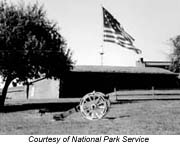


After the First Lady visits the Francis Scott Key memorial, she will arrive at Fort McHenry, a crucial battleground for America during the War of 1812. British soldiers, who had burned Washington, D.C. turned their attention to the city of Baltimore. The British realized that Fort McHenry must be captured or destroyed if they were to succeed. The fort was attacked at dawn on September 13 in a bombardment that lasted for 25 hours. When a diversionary attack by the British failed, their troops sailed away. Secure in their victory over the British at this crucial battle, the American soldiers fired the morning gun and hoisted the large flag that would later become known as the Star-Spangled Banner while the musicians played Yankee Doodle. The British headed off to New Orleans where they were defeated by a frontier army led by Major General Andrew Jackson in the last important battle of the War of 1812.
The repulse of a British naval attack against this fort in 1814 prevented the capture of Baltimore and inspired Francis Scott key to write the poem, Defense of Fort McHenry, eventually set to music and now known as the Star-Spangled Banner. It became our National Anthem in 1931.
During the Civil War, Fort McHenry was used as a temporary prison for captured Confederate soldiers, Southern sympathizers, and political prisoners. From 1917 until 1923, U.S. Army General Hospital No. 2 was located here to serve World War I veterans. The Francis Scott Key Monument was unveiled in 1922 by President Harding. A large figure of Orpheus in bronze, playing a five-stringed lyre, it is the work of Charles Henry Niehaus. In 1925, Congress made Fort McHenry a national park; 14 years later it was redesignated a national monument and historic shrine, the only park in the country to have this double distinction.
Ft. McHenry serves as the nations flagpole by providing the ceremonial location to unveil new national flags.
To comment on this service,
send feedback to the Web Development Team.
![[White House icon]](/New/images/home_pin.gif)
![[Help Desk icon]](/New/images/help_pin.gif)